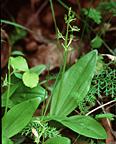Liparis loeselii (L.) Rich.
Loesel's twayblade, fen orchid
The specific epithet loeselii honors Johann Loesel, a seventeenth
century Prussian botanist.

DESCRIPTION:
Plant glabrous, 10-25 cm tall, arising from an cluster of slender roots;
base of the stem swollen to form a pseudobulb. Leaves 2 (1 in sterile
plants), essentially basal, ovate-elliptical to oblong, 4-10 cm long and
2-5 cm wide, generally yellowish-green. Midrib prominent, forming a keel
below. Inflorescence a loose to dense, elongate raceme of yellowish-green
flowers, spicate, 2-25 flowered; each flower subtended by a minute lanceolate
bract. Sepals oblanceolate, 5-6 mm long and about 1 mm wide, yellowish-green
to green, the margins revolute. Petals linear, filiform, 4-5 mm long
and about 0.5 mm wide, colored as the sepals; typically reflexed. Labellum
oblong, arcuate-recurved, minutely apiculate at apex, 4-5 mm long and 2-3
mm wide, colored as sepals and petals; central portion of the labellum typically
thickened and darker in color.
SIMILAR SPECIES: Liparis loeselii would most likely be confused
with L. lilifolia. In flower, the two
can be distinguished by the color of the flowers, which are only rarely
green in L. lilifolia, but always green
in L. loeselii. Green-flowered specimens L.
lilifolia can be separated from L. loeselii by their relatively
long pedicels (typically greater than 9 mm) and wider labellum and leaves.
Fruiting plants of the two species can also be separated by pedicel length.
HABITAT: In Wisconsin, Liparis loeselii is typically found growing
in a variety of moist, sterile habitats. Likely sites would be bogs, wet
ditches, old sand pits and moist meadows. While it often grows in acidic
soils, it can be found just as frequently in strongly basic soils. The critical
factor seems to be a lack of competing vegetation (as is the case for many
of our native orchids--particularly those with basal leaves). I have seen
L. loeselii in one unusual habitat in Wisconsin--a dry oak savannah
remnant in Sauk County. However, the plants here were scattered under shrubs,
which probably kept the soil somewhat more moist than in the surrounding
vicinity.
FLOWERING DATES: June 10-July 20.
POLLINATION: Catling (1980)
has documented rain-assisted autogamy in Liparis loeselii. Rain drops
hit and dislodge the pollinia into the stigma, apparently assisted by the
upturned labellum which properly deflects the raindrops toward the anther.
WI DISTRIBUTION:  U.S. DISTRIBUTION:
U.S. DISTRIBUTION:
Go directly to Wisconsin herbarium records.
Return
to the main LIST of the Orchids of Wisconsin.
Return to the main KEY to the Orchids of
Wisconsin.

 U.S. DISTRIBUTION:
U.S. DISTRIBUTION: